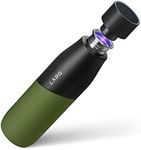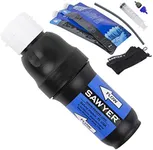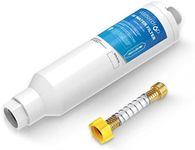Buying Guide for the Best Travel Water Purifier Bottle
Choosing a travel water purifier bottle is all about ensuring you have safe, clean drinking water wherever you go. These bottles are especially useful for travelers, hikers, campers, or anyone spending time in areas where water quality is uncertain. The right bottle can protect you from harmful bacteria, viruses, and other contaminants, making your adventures safer and more enjoyable. To find the best fit, it's important to understand the key features and how they relate to your specific needs and travel habits.Filtration TechnologyFiltration technology refers to the method the bottle uses to clean water. Common types include activated carbon filters, hollow fiber membranes, and UV purification. This is important because different technologies remove different contaminants. For example, carbon filters are good for improving taste and removing chemicals, while hollow fiber membranes are effective against bacteria and protozoa. UV purifiers can neutralize viruses as well. If you’re traveling to places with questionable water sources, a bottle that covers bacteria, protozoa, and viruses is best. For hiking in areas with clear streams, a simpler filter may suffice. Consider where you’ll use the bottle most to decide which technology is right for you.
Filter LifespanFilter lifespan tells you how much water the filter can purify before it needs to be replaced. This is usually measured in liters or gallons. A longer lifespan means less frequent replacements, which is convenient for long trips or regular use. Shorter lifespans might be fine for occasional travel. If you plan to use the bottle daily or for extended trips, look for a filter with a high capacity. For short vacations or infrequent use, a lower lifespan may be sufficient and can help keep the bottle lighter.
Purification SpeedPurification speed is how quickly the bottle can make water safe to drink. Some bottles filter water as you sip, while others require you to wait a few minutes after filling. Faster purification is helpful if you need water on the go or are traveling with a group. Slower options may be fine if you have time to wait. Think about your travel style—if you’re often in a hurry or need to hydrate quickly, choose a bottle with instant or fast filtration.
Bottle CapacityBottle capacity is the amount of water the bottle can hold, usually measured in ounces or liters. Larger bottles mean you can carry more water, which is useful for long hikes or places with limited water sources. Smaller bottles are lighter and easier to carry, making them good for city travel or short outings. Consider how much water you typically drink and how often you’ll have access to refill stations to pick the right size for your needs.
Weight and PortabilityWeight and portability refer to how heavy and easy to carry the bottle is. Lightweight bottles are better for backpacking or travel where every ounce counts. Heavier bottles may offer more features but can be cumbersome. If you’re traveling light or moving around a lot, prioritize a compact, lightweight design. For car camping or situations where weight isn’t a concern, a sturdier bottle may be acceptable.
Ease of Use and CleaningEase of use and cleaning describes how simple it is to operate and maintain the bottle. Some bottles require squeezing, pumping, or special steps to purify water, while others are as easy as filling and drinking. Cleaning is important to prevent mold and bacteria buildup. If you want a hassle-free experience, look for bottles with straightforward operation and parts that are easy to take apart and wash. If you don’t mind a bit of extra work for more thorough purification, a more complex system may be suitable.
Contaminant RemovalContaminant removal indicates what types of harmful substances the bottle can filter out, such as bacteria, protozoa, viruses, chemicals, and heavy metals. This is crucial for your safety, especially in areas with poor water quality. Some bottles only remove bacteria and protozoa, while others also handle viruses and chemicals. If you’re traveling to developing countries or remote areas, choose a bottle that covers the widest range of contaminants. For use in places with treated water, a basic filter may be enough.

















